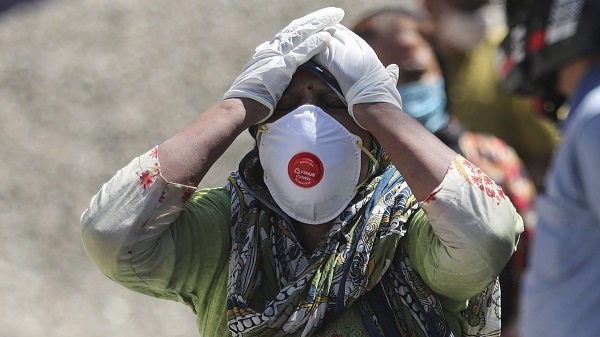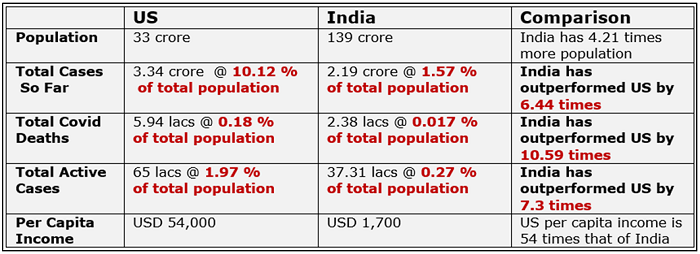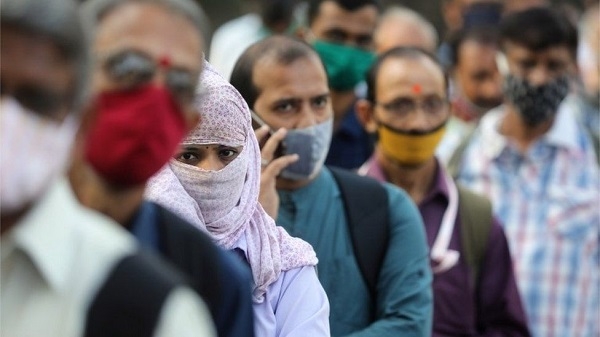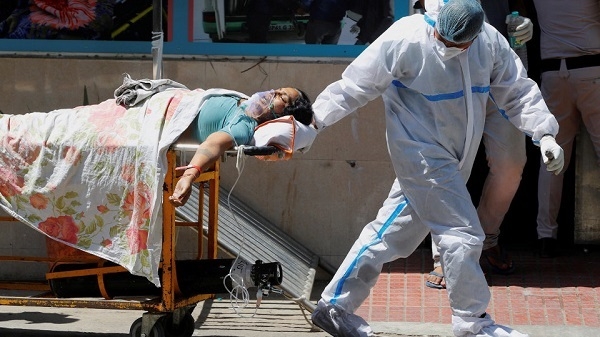Pandemic and the Indian Response
20 May 2021 10:53:29
This write up concerns four points only.
One, Indian TV channels are vying with each other to get ‘pearls of wisdom’ from Dr Anthony S. Fauci as regards India’s management of Covid-19 pandemic. Undoubtedly, Dr Fauci has impressive credentials. He is a physician-scientist and immunologist of repute and is the chief medical advisor to the US president.

The way Dr Fauci lectures India, one thought that he would have managed the pandemic in the US in an outstanding manner and saved lacs of US lives. Once the information available in the public domain was tabulated, the picture that emerged was totally different. Please see the table below.

To summarise the above findings, India has done better than the US by 6.44 times as regards the total case; 10.59 times as regards the deaths; and 7.3 times as regards the total active cases. What have we to learn from Dr Fauci? In fact, the US TV channels should have been seeking advice from Indian experts on managing the pandemic. Who gives counsel – the one who performs better or the one who fails?
Although a comparison has been carried out between the US and India, it must be borne in mind that the US is one of the most advanced nations in the world, boasting of incomparable medical infrastructure with a per capita income of USD 54,000. On the other hand, India is still a struggling nation with a per capita income of mere USD 1,700. Yet, instead of being proud of our achievement, we seek guidance from those who have been a failure in their own country. How else can slave-mentality be defined?
Two, who is responsible for the health infra-structure in India? The State List is given in Schedule Seven to the Constitution of India. At Serial 6, it includes ‘health and sanitation; hospitals and dispensaries’. The Central government is responsible only for the formulation of overall national health policy.
During the onset of Covid-19 last year, the Centre rightly stepped in to guide the nation through the unprecedented challenges of the pandemic. It did handholding of the states to see the nation through those difficult times as the states could not have fought the pandemic by their own efforts alone. It had to be a national campaign and the Centre fittingly took it upon itself to initiate a coordinated effort. However, once the initial wave ebbed and the economy needed to be opened up, the Centre asked the states to assume their responsibility of health care. States were duly warned of the impending second wave and asked to ramp up their medical infrastructure. In fact, the Centre went out of its way to allocate additional resources. Whereas some states took necessary measures, many were simply languid and slothful. They did not take the warnings of the second wave seriously.
Take the case of Pressure Swing Adsorption (PSA) Oxygen Plants. The Centre sanctioned funds for 162 plants in October 2020 but only 33 had been set up by mid-April this year. Delhi was allotted 8 plants, but set up only one. Similarly, Maharashtra was allotted funds for 10 plants, but set up only 1. Many hospitals declined to have these plants as in-house generation of oxygen would have put an end to the lucrative business of local purchase of cylinders.

One is amazed at the functioning of the higher judiciary. Are the courts unaware that health care is a state subject? Why are they not questioning the states as regards their lethargic and disinterested approach? Is it the responsibility of the Centre to ensure that every municipal and state hospital has adequate beds and oxygen? Can the hospitals and the authorities controlling them be absolved of their criminal ineptitude? When a hospital or the state government goes crying to the courts for short-supply of oxygen, the courts should take them to task for their ill-preparedness. How can the Centre be held responsible if a city does not have adequate number of ambulances? There is a limit to which the courts can display their ignorance of the facts.
Three, pictures of burning pyres do give perverse satisfaction to those who feast on Indian’s misfortune. Unfortunately, we have plenty of anti-national presstitutes who compete amongst themselves to obtain the most morbid picture for the Western media. What can be more macabre than the shots of rows of burning pyres, taken from drones? Reportedly, some pictures sell for as much as Rs 29,000 apiece. The Western press publishes them with glee, shamefully forgetting that even the US had to keep the dead bodies in cold storage as it could not handle so many burials.
Pictures of the dead bodies lying in wait in a queue for their turn for cremation have also being making rounds. One is surprised that such overcrowding of crematoriums is being attributed totally to Covid to show the government in a poor light. In India, crematoriums in big cities are always overloaded. Yes, Covid has added to the problem but wait for hours in nothing unusual. I recall that in 1985, we had to wait for more than 18 hours at a cremation ground in Delhi before we could take the dead body of our aunt for cremation. Pictures of Manikarnika Ghat of Varanasi are also being circulated with seditious motive – night-time shots of rows of flaming pyres on the banks of the river, with their reflections in the water imparting distressing undertone. It is intentionally hidden that Manikarnika Ghat always has tens of pyres burning. In fact, they have a waiting list. According to the Hindu faith, many believe that cremation at this place will get them salvation. Hundreds of old and ailing people come to Varanasi to await their end. Hosts of Dharamshalas have been constructed by the philanthropist to house them. Therefore, circulation of pictures of Manikarnika Ghat with Covid subtexts is tantamount to journalistic dishonesty and deceitfulness. How low can the press stoop! It may come as a surprise to many that Manikarnika Ghat is an unmissable stopover of the tourist circuit of Varanasi. Hordes of foreigners can be seen negotiating narrow lanes to get a closer look.

Four, when a mature nation faces an unprecedented challenge, it stays united like a rock behind the national leadership. Churchill became the Prime Minister of the UK in 1940. His Conservative Party was faction ridden and he was not the unanimous choice. However, once the war started, the whole country rallied behind him. All intra-party and inter-party differences were buried. Nevertheless, elections held after the war saw him losing to Attlee. Modi is the elected leader of the country. People of India have reposed faith in him. Covid-19 is a challenge of unheard of proportions. Lives of millions are at stake. Economy has to be protected. It is tight rope walking and a fine balance is required to be maintained. There are no precedents to go by. Countries are learning the hard way. As seen above, even a nation like the US has also floundered.
Instead of spreading negativity and disaffection, we will do well to strengthen the hands of the governments, both at the Centre and the states. Let us get over this pandemic together, we will have enough opportunities to do politics and pull each other down. In any case, we are adept at it as it is a part of our national character. The courts will do well to do the job assigned to them – dispensation of justice and settlement of lacs of pending cases. Governance should be left to the duly elected representatives of the people. Agreed that Modi is not perfect. With the benefit of hindsight, we can say that he could have done better. Fair enough. If dissatisfied with his leadership, we can elect someone else in 2024 – just three years away. However, till then, it is unconstitutional to pull him down. Intolerance for Modi cannot be taken to the extent where it stinks of viciousness and vendetta.
Finally, a question commonly asked is what makes a nation great. How could a small nation like Britain rule half the world? On the other hand, why has India succumbed to foreign rule so often? Well, the difference is here for all of us to see. The British stand by their national leadership in times of crisis while we further our selfish agenda. Who is worried about India’s national interests – those who created vaccination hesitancy by questioning it or those who hoard essential medical supplies or those who send out one tweet per day to spread negativity and gloom? Is perfidy in our DNA?
.
.